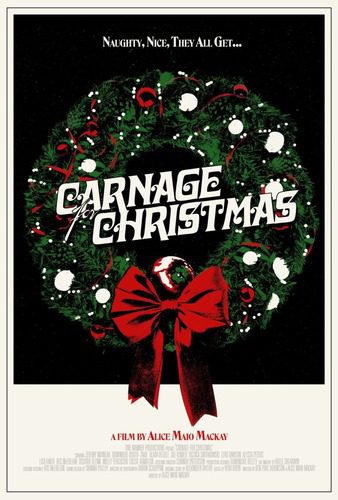Youthful independent filmmaking is distinctly unique. There’s energy and passion and a willingness to experiment you don’t see as often in older peers. A drive to get the shot no matter the cost. It’s a genuinely remarkable thing that serves as a potent reminder of the modern-day alchemy of movie making. That said, there’s two sides to that coin, and Alice Maio Mackay’s Australian horror film, Carnage for Christmas is a primary example of that, for both sides.
Freshly 20 and on her fifth microbudget feature with Carnage for Christmas, Alice Maio Mackay shows a drive and passion to exist in the field of filmmaking. A feature takes a lot of work, from planning, scripting, pre-production, production, and post-production just to hit completion. A lot of compromises must be made to complete a film, especially on low and microbudget films like this one. From there comes one of the rare hard parts of being a critic, properly and fairly critiquing the work. Obviously, one can’t hold a microbudget film to a blockbuster like a superhero movie, so, where is the line? That’s something one must decide as a writer and a critic, and I will do my best.
From the opening, we are introduced to Lola, who gives self-introduction through a featured episode of her true crime podcast. Props to casting, Lola’s actress, Jeremy Moineau, has a smooth voice that would absolutely be making a killing in podcasting or ASMR videos. We’re treated to exposition of her history being transgender and her personal connection with her hometown’s own legend, the Toymaker. This sequence is done in a very impressive motion comic style very similar to the transitional moments in Trick ‘r Treat.
Shortly after her homecoming, having been gone for many years and transitioned since, Lola goes to stay with her sister (with an American accent?). Having to deal with all the stress of returning to a place where you don’t feel welcome is brutal. Add the return of the Toymaker to the mix, and Christmas has been made into a new kind of hell.
While the film has a fairly solid setup, it is limited in more than a few ways. The microbudget shows in the more action oriented kill sequences especially, and in some of the casting. When it comes to the action, the cutaways are awkwardly placed and paced to the point it feels like a magician explaining his trick while he performs it. The audio will imply a killer breaks car windows to get at some characters, but then the camera lingers at awkward angles around the victims in a way that makes it clear they couldn’t afford to make stunt glass, much less break an actual vehicle’s window. I get that; I was a student filmmaker a millennia ago. But most filmmakers learn to get creative to hide their lack of resources or shift away from scenes they cannot practically accomplish.
On the acting side, the writing is very youthful and shows that perspective, and some of the younger actors, especially Moineau, are pretty genuine to accept; however, many of the adults are obviously reading off lines awkwardly and it disrupts the emotional flow of several scenes.
Overall, I’m exceptionally impressed by the tenacity and passion of Mackay, and I would be willing to keep an eye on her career, but personally, I hesitate to recommend this film unless you’re a fan of her work and want to see her progress.

Carnage for Christmas played this year’s Fantasia Film Festival in Canada. Stay tuned for more release information!
 PopHorror Let's Get Scared
PopHorror Let's Get Scared




